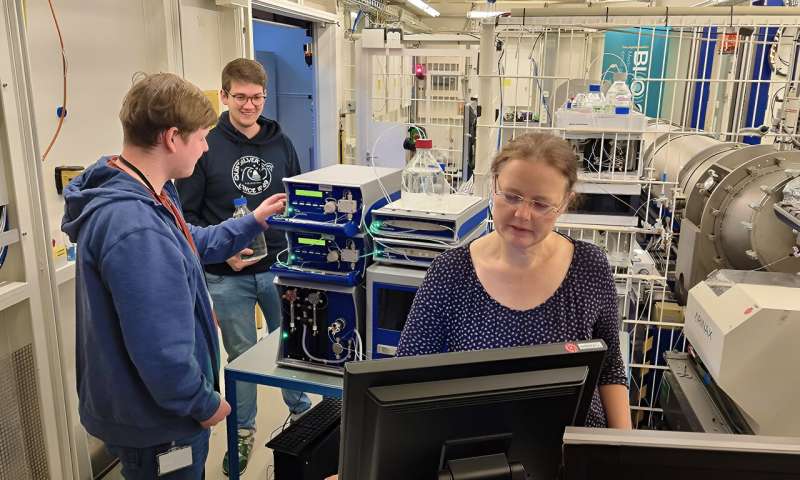This article has been reviewed according to Science X's editorial process and policies. Editors have highlighted the following attributes while ensuring the content's credibility:
fact-checked
peer-reviewed publication
trusted source
proofread
'X-ray vision' for investigation of mRNA nanomedicines

A new technology co-developed at EMBL Hamburg provides new insights into mRNA pharmaceuticals and other nanomedicines, which can be helpful for the development of new products
Messenger RNA (mRNA) nanomedicines, a ground-breaking technology that has led to the development of the first approved COVID-19 vaccine, was recently recognized by the Nobel Prize in Medicine or Physiology. But mRNA's potential for pharmaceutical application is expected to go much beyond this—it could open up new opportunities for the treatment and prevention of diseases, such as viral and bacterial infections, cancer, cardiovascular diseases, and inflammatory and auto-immune diseases. It could also transform the large field of interventions by therapeutic proteins.
Many novel mRNA nanomedicines, which are currently in different stages of development, may become available in the future. One requirement for all applications of mRNA in pharmaceutical products is that they need to be formulated in suitable delivery systems, each designed for different functions and optimized for therapeutic product needs based on the intended application and route of delivery.
Lipid-based nanoparticles are tiny droplets of fat-like molecules that serve as protective packaging for the mRNA. Their properties depend on composition, structure, manufacturing protocol, and other conditions.
An important aspect of nanoparticles is their size. By their nature, nanoparticles can vary a little bit in size, some being a bit smaller, and some a bit larger than the average value. The particle size can have an influence, for example, on the stability and the behavior of the formulations after administration. It is therefore important to control the particle size inside a pharmaceutical product to evaluate and ensure its quality.
Scientists at EMBL Hamburg, Johannes Gutenberg University Mainz, Postnova Analytics GmbH, and BioNTech SE have developed a new method to precisely elucidate the size of all particles in such pharmaceutical products, as well as their structure and how many RNA molecules they carry inside them. The study was conducted based on lipoplex formulations, an mRNA delivering technology developed by BioNTech. The work is published in the journal Scientific Reports.
"So far, it was very difficult to measure all these size-related properties; therefore, often only average values were determined," said Heinrich Haas, one of the leaders of the project. "With our new method, we can determine many size-related features all at once, with a single measurement and for all nanoparticles in a product. This information can be handy to evaluate product quality."
The method will also be applicable for the investigation of other pharmaceutical products.
"Liposomes are another type of pharmaceutical nanoparticles which have been applied for years for the treatment of cancer or infectious diseases such as fungal infections," said Peter Langguth, the project leader at Johannes Gutenberg University Mainz.
"Now even generic liposome products are available on the market, and probably there will be more to come. The new method can be very useful in evaluating the quality of these generics in comparison to the originator products and will pave the way for further high-quality drug products at an even more reasonable cost."
A two-in-one method
What makes the new method so powerful is that it couples two techniques: asymmetrical-flow field-flow fractionation (AF4) and small-angle X-ray scattering (SAXS). AF4 separates lipid-based nanoparticles from other parts of an mRNA nanomedicine and sorts them according to their size.
SAXS allows scientists to determine the structure and the number of sorted particles. To do this unequivocally, only one type of particle must be analyzed at a time, which is why combining sorting and measuring is so critical.
SAXS is one of the key techniques applied and available at EMBL Hamburg as a service for researchers from academia and industry in Europe and beyond. EMBL Hamburg's SAXS beamline at the PETRA III synchrotron, now equipped with the AF4 device—set up with the help of collaborators at Postnova Analytics GmbH—will open up new opportunities not only for studying pharmaceutical nanoparticles, but also for other types of research.
"The combination of these two tools can now be used in many different areas of science," said Melissa Graewert, Staff Scientist at EMBL Hamburg.
"In addition to helping create new medicines, we can also use them to understand how different-sized particles interact in complex biological systems. For example, I've now used this new setup to closely examine how very small plastic debris called nanoplastics, which pollute our waters, can be covered by binding proteins on their surface. A key question is whether this protein shielding enables nanoplastics to travel through our bloodstream, potentially reaching different organs, as they may no longer be recognized as foreign objects by our immune system."
This work follows up on several previous collaborative studies between EMBL Hamburg, BioNTech SE, and Johannes Gutenberg University Mainz, which explored how mRNA can be better formulated and delivered into human cells. The scientists are continuing their collaborative research to further explore the application of mRNA nanomedicines.
More information: Melissa A. Graewert et al, Quantitative size-resolved characterization of mRNA nanoparticles by in-line coupling of asymmetrical-flow field-flow fractionation with small angle X-ray scattering, Scientific Reports (2023). DOI: 10.1038/s41598-023-42274-z
Journal information: Scientific Reports
Provided by European Molecular Biology Laboratory




















